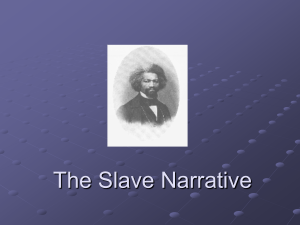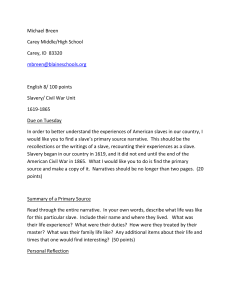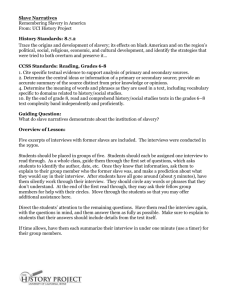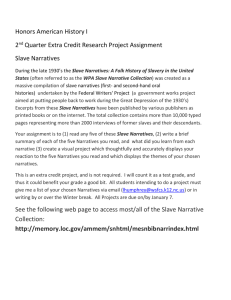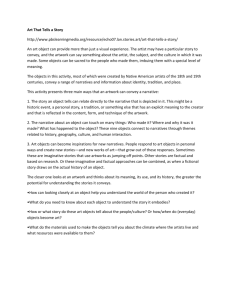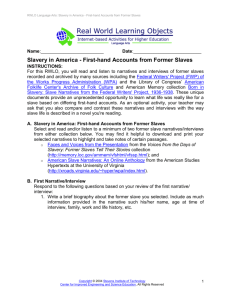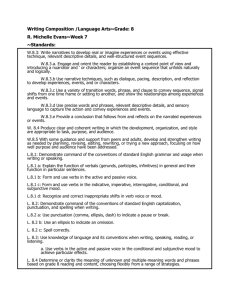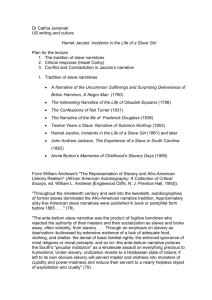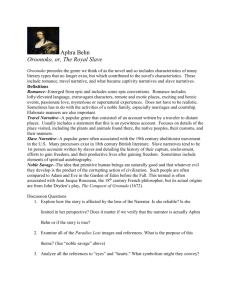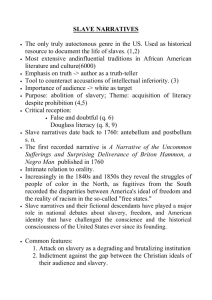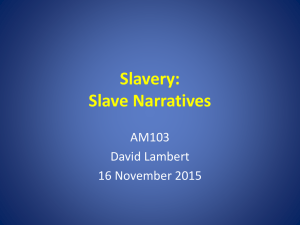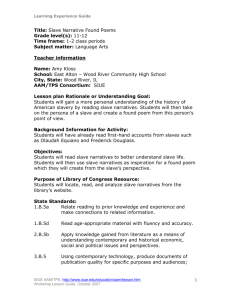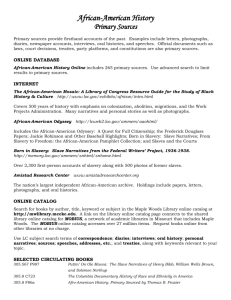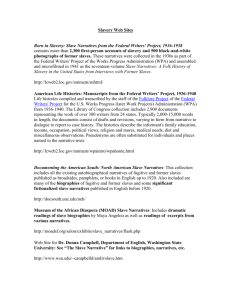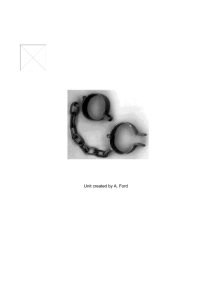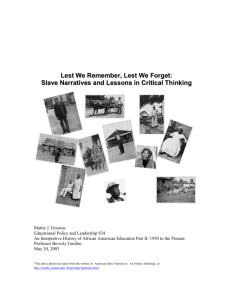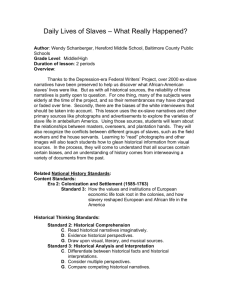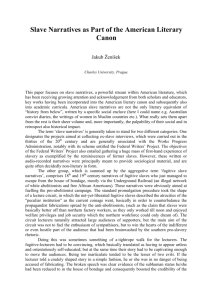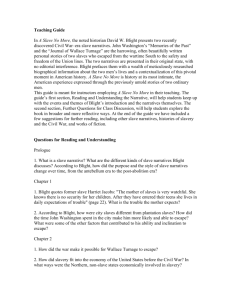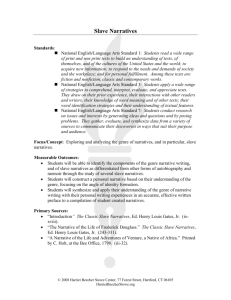Slave Narrative Biography Report
advertisement
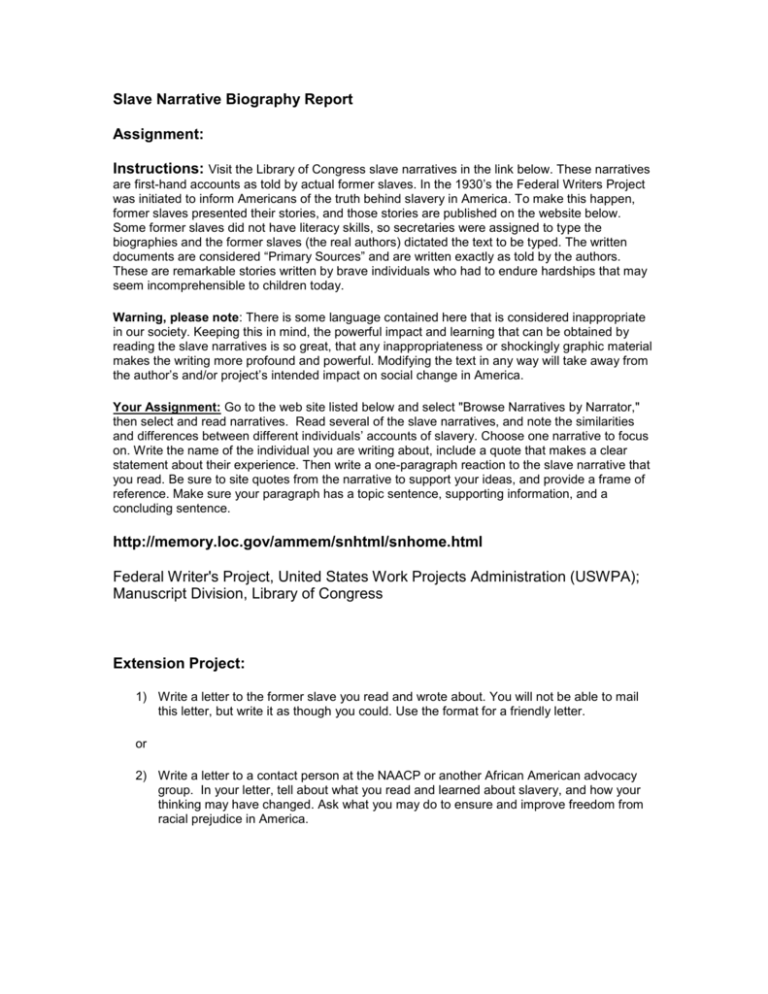
Slave Narrative Biography Report Assignment: Instructions: Visit the Library of Congress slave narratives in the link below. These narratives are first-hand accounts as told by actual former slaves. In the 1930’s the Federal Writers Project was initiated to inform Americans of the truth behind slavery in America. To make this happen, former slaves presented their stories, and those stories are published on the website below. Some former slaves did not have literacy skills, so secretaries were assigned to type the biographies and the former slaves (the real authors) dictated the text to be typed. The written documents are considered “Primary Sources” and are written exactly as told by the authors. These are remarkable stories written by brave individuals who had to endure hardships that may seem incomprehensible to children today. Warning, please note: There is some language contained here that is considered inappropriate in our society. Keeping this in mind, the powerful impact and learning that can be obtained by reading the slave narratives is so great, that any inappropriateness or shockingly graphic material makes the writing more profound and powerful. Modifying the text in any way will take away from the author’s and/or project’s intended impact on social change in America. Your Assignment: Go to the web site listed below and select "Browse Narratives by Narrator," then select and read narratives. Read several of the slave narratives, and note the similarities and differences between different individuals’ accounts of slavery. Choose one narrative to focus on. Write the name of the individual you are writing about, include a quote that makes a clear statement about their experience. Then write a one-paragraph reaction to the slave narrative that you read. Be sure to site quotes from the narrative to support your ideas, and provide a frame of reference. Make sure your paragraph has a topic sentence, supporting information, and a concluding sentence. http://memory.loc.gov/ammem/snhtml/snhome.html Federal Writer's Project, United States Work Projects Administration (USWPA); Manuscript Division, Library of Congress Extension Project: 1) Write a letter to the former slave you read and wrote about. You will not be able to mail this letter, but write it as though you could. Use the format for a friendly letter. or 2) Write a letter to a contact person at the NAACP or another African American advocacy group. In your letter, tell about what you read and learned about slavery, and how your thinking may have changed. Ask what you may do to ensure and improve freedom from racial prejudice in America. Standards Addressed in Slave Narrative assignment: English Language Arts Standards » Reading: Informational Text » Grade 7-8 Key Ideas and Details RI.8.1. Cite the textual evidence that most strongly supports an analysis of what the text says explicitly as well as inferences drawn from the text. RI.8.2. Determine a central idea of a text and analyze its development over the course of the text, including its relationship to supporting ideas; provide an objective summary of the text. RI.8.3. Analyze how a text makes connections among and distinctions between individuals, ideas, or events (e.g., through comparisons, analogies, or categories). Craft and Structure RI.8.5. Analyze in detail the structure of a specific paragraph in a text, including the role of particular sentences in developing and refining a key concept. RI.8.6. Determine an author’s point of view or purpose in a text and analyze how the author acknowledges and responds to conflicting evidence or viewpoints. Integration of Knowledge and Ideas RI.8.9. Analyze a case in which two or more texts provide conflicting information on the same topic and identify where the texts disagree on matters of fact or interpretation. Language: Conventions of Standard English L.8.1. Demonstrate command of the conventions of standard English grammar and usage when writing or speaking. o Form and use verbs in the active and passive voice. o Recognize and correct inappropriate shifts in verb voice and mood.* L.8.2. Demonstrate command of the conventions of standard English capitalization, punctuation, and spelling when writing. o Use punctuation (comma, ellipsis, dash) to indicate a pause or break. o Spell correctly. Vocabulary Acquisition and Use L.8.4. Determine or clarify the meaning of unknown and multiple-meaning words or phrases based on grade 8 reading and content, choosing flexibly from a range of strategies. o Use context (e.g., the overall meaning of a sentence or paragraph; a word’s position or function in a sentence) as a clue to the meaning of a word or phrase. Writing: Text Types and Purposes W.8.1. Write arguments to support claims with clear reasons and relevant evidence. o Introduce claim(s), acknowledge and distinguish the claim(s) from alternate or opposing claims, and organize the reasons and evidence logically. o Support claim(s) with logical reasoning and relevant evidence, using accurate, credible sources and demonstrating an understanding of the topic or text. o Use words, phrases, and clauses to create cohesion and clarify the relationships among claim(s), counterclaims, reasons, and evidence. o Establish and maintain a formal style. o Provide a concluding statement or section that follows from and supports the argument presented. W.8.2. Write informative/explanatory texts to examine a topic and convey ideas, concepts, and information through the selection, organization, and analysis of relevant content. o Introduce a topic clearly, previewing what is to follow; organize ideas, concepts, and information into broader categories; include formatting (e.g., headings), graphics (e.g., charts, tables), and multimedia when useful to aiding comprehension. o Develop the topic with relevant, well-chosen facts, definitions, concrete details, quotations, or other information and examples. o Use appropriate and varied transitions to create cohesion and clarify the relationships among ideas and concepts. o Use precise language and domain-specific vocabulary to inform about or explain the topic. o Establish and maintain a formal style. o Provide a concluding statement or section that follows from and supports the information or explanation presented. W.8.3. Write narratives to develop real or imagined experiences or events using effective technique, relevant descriptive details, and well-structured event sequences. o Engage and orient the reader by establishing a context and point of view and introducing a narrator and/or characters; organize an event sequence that unfolds naturally and logically. o Use narrative techniques, such as dialogue, pacing, description, and reflection, to develop experiences, events, and/or characters. o Use a variety of transition words, phrases, and clauses to convey sequence, signal shifts from one time frame or setting to another, and show the relationships among experiences and events. o Use precise words and phrases, relevant descriptive details, and sensory language to capture the action and convey experiences and events. o Provide a conclusion that follows from and reflects on the narrated experiences or events. Production and Distribution of Writing W.8.4. Produce clear and coherent writing in which the development, organization, and style are appropriate to task, purpose, and audience. (Grade-specific expectations for writing types are defined in standards 1–3 above.) W.8.5. With some guidance and support from peers and adults, develop and strengthen writing as needed by planning, revising, editing, rewriting, or trying a new approach, focusing on how well purpose and audience have been addressed. W.8.6. Use technology, including the Internet, to produce and publish writing and present the relationships between information and ideas efficiently as well as to interact and collaborate with others. Research to Build and Present Knowledge W.8.7. Conduct short research projects to answer a question (including a self-generated question), drawing on several sources and generating additional related, focused questions that allow for multiple avenues of exploration. W.8.8. Gather relevant information from multiple print and digital sources, using search terms effectively; assess the credibility and accuracy of each source; and quote or paraphrase the data and conclusions of others while avoiding plagiarism and following a standard format for citation. W.8.9. Draw evidence from literary or informational texts to support analysis, reflection, and research.

